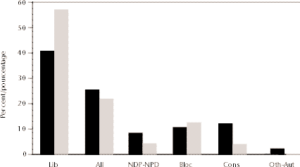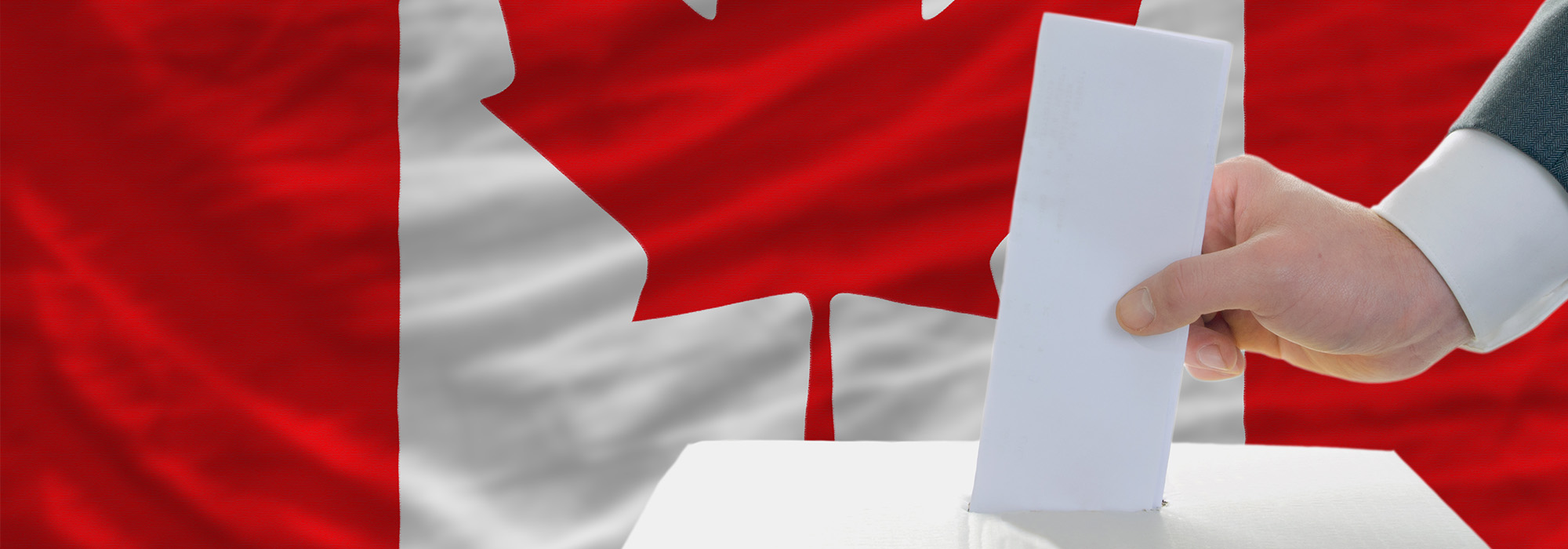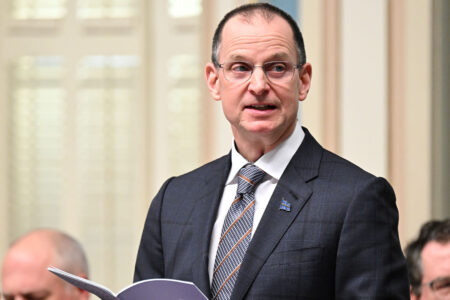
Commentators bemoaned the crass behavior of participants on this summer’s ”reality television” programming, but paid little attention to the ”institutional structure” devised by show producers. If participants win by voting their competitors off the island, it can hardly be surprising that some participants both combined to eliminate their most worthy opponents and misled these opponents about their intentions.
As they collectively bemoan some aspects of our recent federal election, the Canadian punditry are equally likely to give short shrift to the idea that we behave the way we do because of the ”institutional structure” we have given ourselves. But of course we do. Which means that simple institutional reforms could solve at least a couple of serious problems.
Rightly or wrongly, many Canadians voiced a healthy scepticism about one or both of the two major pan-Canadian parties. Much of their frustration with the electoral process came from a feeling that they could not vote for their favourite candidate but instead had to vote strategically for a candidate who stood a chance of beating their least-favoured candidate; leaders of both major parties stoked this frustration by warning of the danger of wasting votes on other parties. But the dissatisfaction that many Canadians feel about having to vote strategically could be erased by a simple adjustment in our institutional structure to allow preferential voting (PV). Instead of voting for just one candidate, voters could rank the candidates: 1st, 2nd, 3rd, and so on. If no candidate won a majority of the votes on the count of 1st preferences, scrutineers would then add in the ”second choices” of candidates who had failed to poll a minimum number of ”first-choice votes.” The vote count would continue until only two candidates remained.
Preferential voting has already been tried in Canada, notably in British Columbia some decades ago. In my view, its most important effect would be the sense of actualization it would arouse in voters, but of course it might also change the final outcomes of elections. It is not at all clear, however, which of the four pan-Canadian parties stands to gain or lose the most from such an innovation. The current prevalence of strategic voting means we don’t know what voters’ real first preferences were, and neither pollsters nor Elections Canada systematically record second choices. Both the Liberals and Alliance maintained during the election that Conservative votes were most likely to flow to them, while the Liberals might seem the more obvious second choice for New Democrats, except perhaps in regions where a sense of alienation runs strong. For their part, the Conservatives and New Democrats could reasonably expect to garner more ”first-choice” votes if their supporters could be spared the temptation–or the perceived necessity–of voting strategically. And they could reasonably expect some ”second-choice” votes in constituencies in which they out-polled one of the two other parties in terms of first choices.
The party that would probably be hurt the most by preferential voting would be the Bloc. Though some Quebec voters were apparently choosing between voting against the Liberals or against the sovereigntists, it is likely that most first preferences for a federalist party would flow thereafter to other federalist parties. Indeed, Quebec sovereigntists might justifiably fear that proportional representation at the national level would set a precedent, since they won in 1998 with fewer votes than the provincial Liberals. On the other hand, as long as the provincial Liberals are able to scare federalists away from vote splitting, it will be difficult for another federalist party to arise in Quebec. Unfortunately for federalists, this also ensures that if the voters grow tired of a Liberal government they have no other federalist alternative to turn to.
Although it is ultimately unclear which parties would benefit most from preferential voting, some might worry that preferential voting provides implicit support for a multi-party system. To be sure, preferential voting is unnecessary when voters face only two choices. But the reverse is not true: The existence of preferential voting does not ensure that there are more than two choices. It merely allows voters to better and more easily respond to such a situation if it does arise. Indeed, British Columbia’s experiment with preferential voting is thought to have ended because it was viewed as being of little value in a province that, even under PV, continued to be dominated by two parties.
Preferential voting does not ensure that there are more than two choices. It merely allows voters to better and more easily respond to such a situation if it does arise.
One clear drawback of preferential voting is that it would slow down the vote count. All votes must first be counted to determine which candidates polled the fewest, and then the second-choice votes of their supporters have to be added to the totals for other candidates. Unless we move to a mechanical or electronic system of vote counting (which recent American experience suggests would bring its own problems), the final results for many constituencies will take hours to tabulate. This would make election night a lot longer for those of us who sit glued to our televisions until the bitter end, but the evening would be a bit more exciting for all that. The new system of staggered closing times across the country has, after all, replaced what used to be a very gradual time zone creep with a suspense-killing deluge of results from five of the six largest provinces. Preferential ballots would add the excitement of finding out who won the ”second-choice” vote.

Against this drawback must be counted the easing of voter frustration, not only before the vote, but after. The winning candidate will no longer be able to squeak in with 30 per cent of the vote or less, as often happens now, but will almost always eventually receive over 50 per cent of votes cast (unless many voters choose not to list a full set of preferences). Members of Parliament will thus have a much less questionable claim to represent the views of their constituents, a not inconsiderable step forward for a democracy.
Preferential voting probably would not have prevented us from yet again electing a Parliament which is deeply divided along regional lines–although who knows? Perhaps the anti-Liberal vote would have coalesced in some Ontario ridings, and the anti-Alliance vote in some Western constituencies. But if preferential voting could not solve the problem of regional imbalance, another fairly simple institutional change–allowing a degree of proportional representation (PR)–clearly would. Vote totals are much less regionally skewed than seats, and thus any degree of proportional representation by province would reduce the regional differences that currently exist.
One objection to proportional representation is that it is more likely to produce minority government. This is certainly observed in countries, like Israel, which rely entirely on proportional representation, and to a lesser extent in countries, such as Germany, which rely on a mixture of constituencies and proportionality.
But we need not go as far in implementing PR as these other countries. Moreover, the implicit premise that minority governments are bad could be debated. Against the claim that majority governments are stronger could be marshalled several claims: that it is inherently undemocratic for a party with only 40 per cent support to wield majority power; that a search for consensus across party divisions can be healthy; and that minority governments often work well. (Admittedly, anyone watching Israeli politics these days may be unmoved, or not, by any of these arguments.)
Granted, the results of Election 2000 might be interpreted as suggesting that Canadians favour majority governments. After all, they, or at least 41 per cent of them, elected one. But, for the reasons discussed above – including the different way the election played out in the various regions – we should be wary about such a conclusion. And without actually having asked them we should certainly not conclude that the Canadian people would reject proportional representation. Whatever one thinks of referenda in general, a case can surely be made that the method by which we elect our politicians should reflect the wishes of voters rather than politicians.
Without actually having asked them we should certainly not conclude that the Canadian people would reject proportional representation.
Moreover, as suggested, there is no need to follow the Israeli model. We could achieve much in terms of limiting regional conflict with a limited degree of proportionality that would leave most majorities intact. Imagine that we held aside some 10 per cent of constituencies in each province (and perhaps even for regions within the two largest provinces); say one seat in each of the Atlantic provinces, two each on the Prairies, three in BC, eight in Quebec, and ten in Ontario. These could then be assigned (sequentially in provinces with more than one) to the parties whose proportion of seats was below their proportion of the votes by the greatest amount. In the most recent election, this would undoubtedly have produced more Western Liberal MPs, and some additional representation of the Alliance, PCs, and/or NDP in Ontario. (I will not make precise calculations from existing vote totals for the simple reason that, at the moment, voters vote for both party and candidate. Without asking explicitly it is hard to know voters’ true party preference.)
Limited PR also would likely have allowed for greater Conservative and even Alliance representation from Quebec. The Liberals’ nationwide seat total might have fallen, though not by enough to threaten their majority. (In 1997, however, their five-seat majority might well have been turned into a minority had limited PR been in effect).
This is just a coincidence (really!) but again the Bloc would probably be the clearest (though not likely the largest) loser from limited PR. Since it won half the seats in Quebec with fewer than half the votes, it would almost certainly win fewer seats in Quebec under PR. By not running candidates elsewhere in the country it currently has no opportunity to make up this deficit, though the possibility should not be dismissed that the Bloc would field candidates elsewhere if proportionality were introduced. (If Ontario’s ten proportionality seats were calculated on a province-wide basis, it might need as little as one per cent of the province-wide vote to win a seat–since Ontario has 103 MPs.) And, of course, if the Bloc’s downward trajectory continues, it might benefit from proportionality in some future election in which its proportion of Quebec seats fell below its proportion of the vote count.
Such a minimal degree of proportionality not only would give all pan-Canadian parties a broader regional presence, thus making each party caucus, not to mention the federal cabinet, more representative of the whole country. It would also allow voters who wished to support a party which has limited support in their province to feel enfranchised (and represented!). And it would allow many voters who feel uncomfortable about taking their concerns to an MP whom they did not vote for to approach another ”provincial” MP.
To be sure, there are potential problems with how the parties would choose the list of their provincial representatives to be elected by proportional representation. We could adopt a rule that would reward the constituency candidates that came closest to winning. This might introduce yet another strategic voting problem for voters who might wish to have two (or more!) of their constituency’s candidates sent to Ottawa. It might also take some of the excitement out of really close elections–since losers could win, too. On the other hand, a good argument can be made that it would only be fair that a candidate who lost by only a couple of votes should go to Ottawa along with the victor (though only if their party earned seats on a proportional basis in their province).
We should not cling to the status quo simply because we are accustomed to it.
Another option would be for the provincial wings of the parties to choose their own list. Some would worry that such choices might be dominated by the party ”establishment,” even if the choice were left to a vote at the regular party convention. On the other hand, nobody who has attended a constituency nomination meeting could claim that they are an ideal way to choose our representatives. It might be especially tempting for national leaders to appoint such ”list” candidates–which would be good or bad depending on how one views such appointments. Once chosen, however, they would face a peculiar incentive: Their chance of going to Ottawa would depend crucially on their party faring poorly in constituency races. In theory at least, they might thus be tempted to use their influence to the detriment of their parties (an accusation that is occasionally leveled at regional ”backroom” politicians who may wield more influence if their region elects no MPs of their party).

No institutional structure is perfect. But we should not cling to the status quo simply because we are accustomed to it. Both preferential voting and proportional representation have enough in the way of potential advantages to be debated nationally. The problems of multiple parties and regional divisions are not recent phenomena, but have characterized Canadian politics for most of the last century. It remains to be seen whether these institutional changes resonate sufficiently with political leaders for them to encourage political debate.
Photo: Shutterstock







